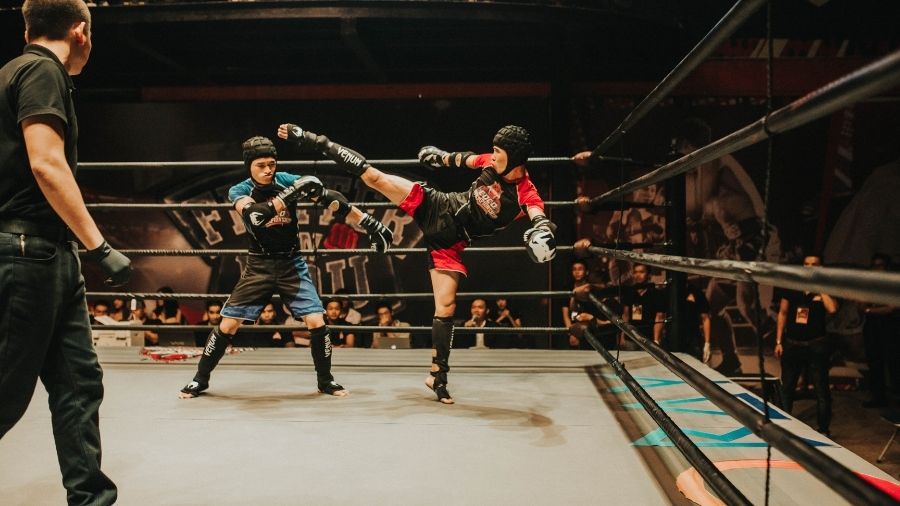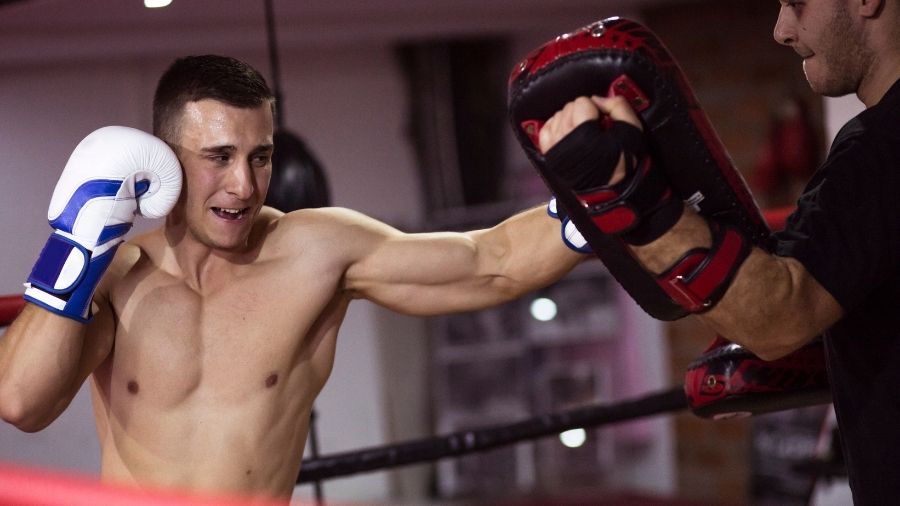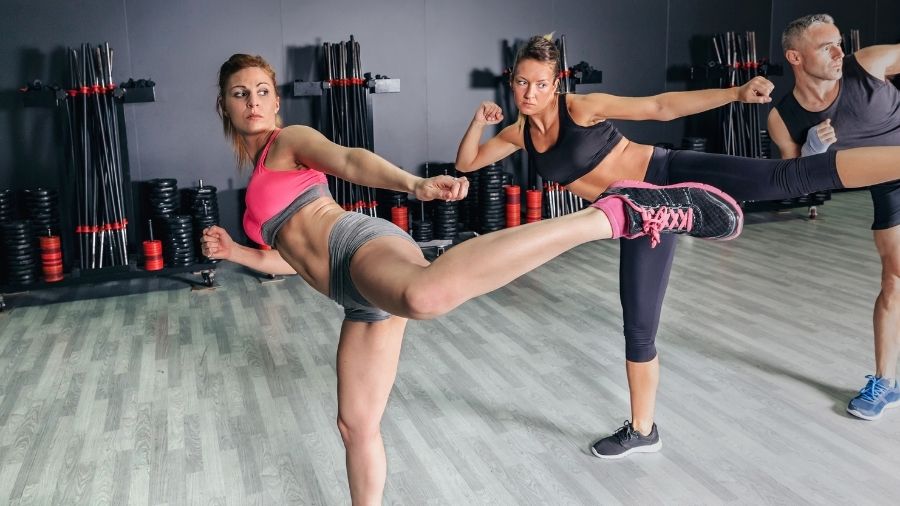Self-defense skills are something everybody should have at least some knowledge and skill in. Some living areas are much more dangerous than others. Still, the knowledge alone that you can handle yourself in a dire situation can be a huge confidence boost.
While we can agree that self-defense skills are necessary, there are many different ways to acquire these skills. Inevitably you’ve asked yourself, is kickboxing good for self-defense?
Full-contact kickboxing is excellent for self-defense and will teach you many physical and mental skills required to handle a real-life altercation.
Of course, there is more to it. I will elaborate on the subject and involve myself in the endless online discussions. Keep reading.
Why Is Kickboxing Good For Self-Defense?
Real fights are violent and messy affairs that are far removed from the controlled and tactical violence of the ring. Still, many kickboxing skills transfer from the gym to the street. Fighting outside the gym or arena should be avoided as much as possible. Still, a situation may arise where you can’t just run and leave a loved one behind.
Discover The Little Known Secrets For Unlocking Devastating KO Power!
Heavy hands are built doing these things...
For these situations, most of the moves used in kickboxing are a great asset to have. Blasting someone with a straight 1-2 in the face will almost always guarantee you the win against an untrained or a career thug.
Here is what kickboxing training will give you:
- Confidence in your skills and mental preparation
- Awareness of your surroundings
- Physical conditioning to engage in a violent scenario
- Defensive and attacking moves
These attributes and skills are fully developed only in full contact training. There is no substitute for sparring and training against a resisting opponent. Many so-called “self-defense” arts may look cool at first glance but are nothing more than a choreographed dance. A karate kata will be just as ineffective but at least looks much better and will teach you some finer body movements and control.
As a combat sport, kickboxing requires endless drilling of techniques against an opponent that, with time, becomes second nature. This comes into play in a real-life scenario, where even a fraction of a second can be decisive. Very often, the victor is the one who strikes first, and the skills you’ve trained the most will automatically come into action.
Another overlooked aspect of combat sports training in general, not just kickboxing, is that it conditions you to stressful situations. Combat can be very shocking, and there is no other way to prepare for it than to engage in aggression and violence.
Although gym training and fights in the ring are far from the chaos of a street altercation, it’s still the best way to prepare aside from actual combat. I doubt the vast majority of people want that.
What Kickboxing Techniques Are Effective In A Real Fight?

Some kickboxing techniques are just better translated to self-defense than others. Let’s look at which is better to use and which to avoid.
Punches To The Head
All punches used in kickboxing are great for a real fight (without the spinning back fist). Most untrained people swing with wide and sloppy haymakers that are very slow and not as powerful as they look. A straight punch is a perfect counter against them.
Jabs and crosses are very fast and much harder to defend than looping hooks. The uppercut is another great punch to use in real life, especially up close.
Body Punches
An excellent shot to the body can also quickly decide the situation in your favor. Remember that fighting on the street is illegal, and even if you are the one being attacked, you will get into trouble if you hurt the opponent badly. A powerful and accurate shot to the liver completely shuts down the body without dealing lasting damage.
Kicks
The kicking arsenal you build in kickboxing is superb, but not everything is suitable for self-defense. Low kicks can be great to slow down the aggressor because they are fast, easy to do, and hurt badly. A kick to the body can also do the trick.
But the higher you go with the kick, the easier it becomes to backfire. Many things can go wrong: you can slip on a slippery surface, your jeans may be tight, and you certainly won’t be warmed up. So, it’s best to keep the high kicks in the gym.
Knees
Modern kickboxing allows for knees, perfect for self-defense. The knee is a perfect option if the opponent gets close to you. And don’t worry about the stupid no clinching rule in kickboxing. Grab the head or shoulders and dig your knee as deep in the bad guys as you can.
Defense
Defense with bare fists is different from defense with kickboxing gloves. The glove provides an excellent shield that protects your blocking hand and increases the blocking surface. Blocking with bare hands is generally done the same as with gloves, but you need to keep a much tighter guard and predominantly use your forearms and elbows, not the hands.
Evasion
The best defense in a fight is evasion, which is twice as important in a self-defense scenario. Always try to stay away from the opponent’s strikes and use evasive moves like slips, dips, and pulling back.
What Kickboxing Techniques To Avoid?

You all know that you should avoid street fights altogether, which is 100% true. But you are not reading this article for this advice, so let’s move on to what moves it’s best to avoid.
Flashy techniques look very cool on film, and many of us grew up watching Jean Claud Van Damme spin kick baddies. But in real life, any spinning technique brings too much risk.
The ground surface may be uneven or slippery, or the assailant may rush at you and take you down while you spin. The flashier the move, the more risk it brings, and in real life, there will be no judge that will let you stand up after a failed rolling thunder.
The other thing you should avoid as a kickboxer is close combat. The primary deficiency of kickboxing in self-defense is the lack of any form of grappling.
If you encounter someone with even basic wrestling skills, you will find yourself in a world of trouble. Other striking martial arts like Muay Thai will prepare you for clinching and body control. Still, kickboxing lacks any form of close combat.
So, suppose you haven’t trained any grappling. In that case, the optimal strategy is keeping your distance and using your straight punches and long kicks to neutralize the opponent.
The simple front kick can prove to be your most valuable weapon. If you are absolutely sure there is no peaceful way out of the situation, strike first and strike hard. Chances are you won’t have the opportunity to do it if you wait too long.
Can Cardio Kickboxing Be Used For Self Defense?

Cardio kickboxing may be an excellent high-intensity workout, but it’s by no means useful in self-defense. Cardio kickboxing moves are derived from actual fighting techniques, but punching the air won’t ever get you ready for punching real targets.
Striking on a dense target develops balance and strength to counter the impact. If you’ve only punched the air, you will be very unpleasantly surprised at how weak your punches are when you hit a hard object.
The other obvious disadvantage is that there is no sparring in cardio kickboxing. This means you have absolutely no experience with any form of combat situation against a resisting opponent, and that leaves you in the same position as any regular untrained person.
Fighting is mainly decided by distance and timing, and the only way to develop them is to train realistically.
Some gyms and instructors may incorporate some pads into cardio kickboxing, and others even include more practical self-defense techniques. But without full contact training, don’t rely on cardio kickboxing to help you with anything other than getting into great shape.
Summary
This article should answer the question: is kickboxing good for self-defense? While most of the skills can be well transferred to self-defense, there is a gaping hole in the arsenal of kickboxing, which is grappling.
If you can learn some basic wrestling skills, you can have a lot more confidence that you can handle almost any situation. And always remember that real-life scenarios have no rules and can have heavy repercussions even if you win.
Thinking you are invincible because you train martial arts may be your last mistake. If you can avoid the fight, always opt for that. If not, your kickboxing skills will serve you well.


